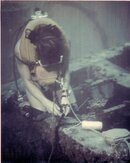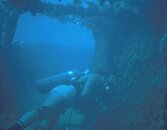FredT
Guest
20 feet of 3/8 rope also makes a good improvised harness, no hardware required. A fair knowledge of knots is handy though. BTDT
Rolling clove at the middle of the line (rope once cut from the roll becomes a line) just below the shoulder. Then allow enough slack to provide arm straps leading to a rolling clove about 18" below the first one. the ends for the waist strap. Complete with a spanish windlass forming the waist buckle tied off with a slip loop, and trim excess line from both ends. Takes about 5 minutes to rig on the back deck. NOT comfortable, but works reasonably well.
Rolling clove at the middle of the line (rope once cut from the roll becomes a line) just below the shoulder. Then allow enough slack to provide arm straps leading to a rolling clove about 18" below the first one. the ends for the waist strap. Complete with a spanish windlass forming the waist buckle tied off with a slip loop, and trim excess line from both ends. Takes about 5 minutes to rig on the back deck. NOT comfortable, but works reasonably well.






